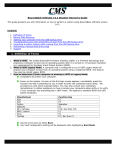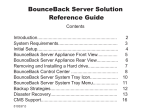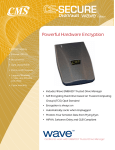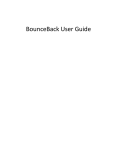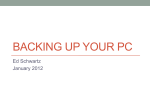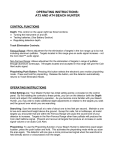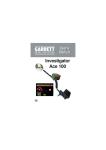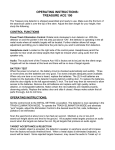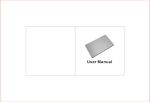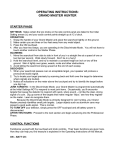Download Hard Disk Installation & Set
Transcript
Installation & Set-Up Guide partition and copy the system files to it making it a bootable drive. If you have an extended partition, type FORMAT D: (or FORMAT E:) followed by the Return key to format the D/E drive. Remove the floppy disk, and when you restart your system, it will boot from your new C drive. 6. Problems? Note: If your original hard drive only had a single partition (you only had a C: drive) and your new drive has multiple partitions, your CD-ROM may have been moved to the next available drive letter after your new hard drive partitions. If you have CDROM based applications installed (those that require the CD-ROM to run), these applications may be expecting to find your CD-ROM drive at D:, which may have changed. If you have problems running these applications, verify the drive letter of your CDROM, and reinstall the CD-ROM applications if the CD-ROM drive is at a new drive letter. There is a known issue with some computers and their PCMCIA card slots. The EasyBundle interface card may not be recognized by your system when you plug the card into the slot. If this is the case, move the card to the other slot and try again. Remember, perform this step of making partitions and formatting them only if you didn’t use EasyMove in Step 1, above. Having problems? Review the steps for removal or installation, then call our Technical Support Department at 1(714) 424-5520. Online support is available at [email protected] and www.cmsproducts.com. 7. Bootable Floppy Disks To be able to boot (start) your computer without a hard disk, you’ll need a floppy disk with certain files and applications on it to boot from. A bootable floppy disk does not come with your computer, and you have to make your own before you remove your hard disk. From the Settings menu, open the control panel window, then open the Add/Remove Programs icon. Select the Start-Up Disk tab, then click the Create Disk button. 5. Review • Use EasyMove (if available) to transfer your data or • If you don’t use EasyMove, back up your data. • Remove the screw on the bottom. • Open the latch and remove the drive cover. • Slide and lift the drive from the computer. • Reinstall the drive. • Replace the drive cover. • Replace the screw on the bottom. • If you didn’t use EasyMove, partition and format the disk, then restore your operating system and data from your backup. Hard Disk Installation & Set-Up Guide Copyright © 1999 by CMS Peripherals, Inc. All rights reserved. No part of this document may be reproduced in any form without prior written consent from CMS. The information and specifications in this document are subject to change without notice. CMS, CMS Peripherals, and the CMS logo are registered trademarks of CMS Peripherals, Inc. Compaq is a trademark of Compaq Computer, Inc. All other trademarks or registered trademarks used herein are the property of their respective owners. 072715.3 June, 1999 For Compaq® Armada 1700 Series & Prosignia 120, 140, & 160 Series Personal Computers To replace your hard disk with 3. Install the new drive your new CMS hard disk drive for your Armada 1700, follow these instructions. Install your new disk drive by following these steps: A. Set the new drive into place in the drive bay with the black CMS logo facing up, and slide it to the left to mate it with the connector. 1. Preserve your data If you’ve used the EasyMove software to transfer the data from the notebook’s original drive to the new StrataDrive, the original drive can now be replaced with the StrataDrive. B. Tuck the pull-tab down between the drive and computer. Replace drive cover previously removed in Step 2B. If you don’t have EasyMove, you should back-up your data using whatever method is best for you (floppies, tape, network, removable drive, etc.). 2. Remove the old disk drive Follow these steps to remove and replace your original drive. A. Make sure your computer is turned Off. Turn the computer over and use a small flat-bladed screwdriver to remove the screw shown in Figure 1. Figure 2 C. Grasp the black fabric pull-tab (it may be tucked in between the disk drive and the computer chassis) and pull the drive to the right to disengage it from the mating connector. Because of the way the pulltab is attached to the drive, pulling it may not be enough to disengage the drive from the connector. If this is the case, carefully push on the silver end of the drive’s bracket and slide it to the right to disengage the connectors. Caution: Pushing on the top cover of the disk drive can cause serious damage to the disk drive. Do not push on the top cover of the disk drive. Carefully lift the drive from the computer as shown in Figure 3. Figure 1 B. Slide the latch towards the center of the computer and lift the small door. Grasp the door and slide the drive cover away from the center of the computer, then lift it to remove it, all as shown in Figure 2. Figure 3 C. Push the latch back down until it latches in place and replace the screw previously removed in Step 2A. The installation is complete. 4. Setting up your new drive If you used EasyMove to transfer your data, your installation is complete. Turn on your computer and you’re back to work. If you didn’t use EasyMove, insert a bootable floppy disk (See Section 7, below) and turn the power on. The computer will automatically determine the drive type for your new disk. From the A: prompt, type FDISK followed by the Return key. Choose option 1 (Create DOS partition or logical drive), then choose option 1, (Create the primary DOS partition), accept the maximum size and activate it. Due to the limitations of Windows 3.1 and early versions of Win’95, the maximum partition size is 2,048 MB. If your new disk is larger than this, you’ll then need to create extended partitions (D and/or E drives) to use the remaining capacity of the disk. Choose option 1 (Create DOS partition or logical drive). Choose option 2 (Create extended DOS partition), then accept the defaults for partition size and logical drive size. Repeat this step to utilize the full capacity of your new disk. Newer versions of Win’95 do not have this limitation and can fully utilize your new large capacity drive as a single partition. When the primary DOS partition is created (and any extended partitions, if required), reboot your system. From the A: prompt, type FORMAT C:/S followed by the Enter key. This will format the primary DOS


